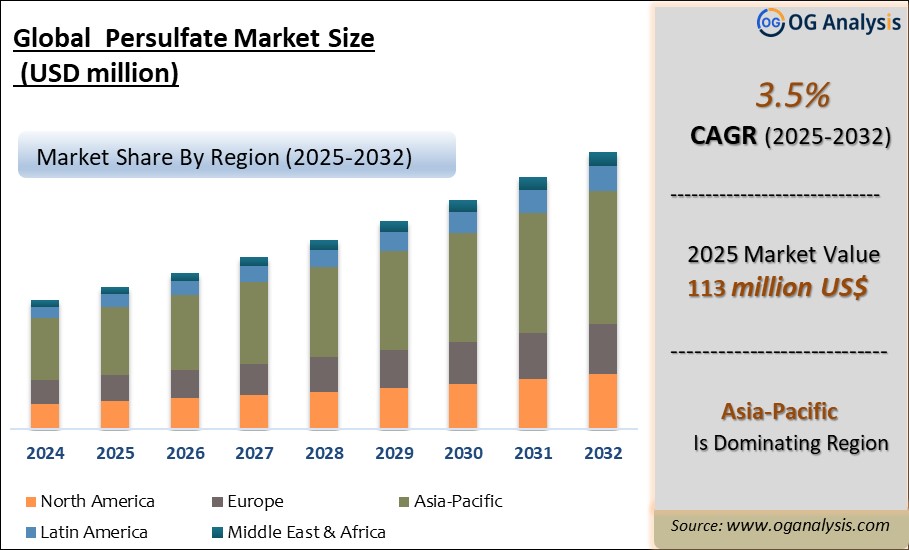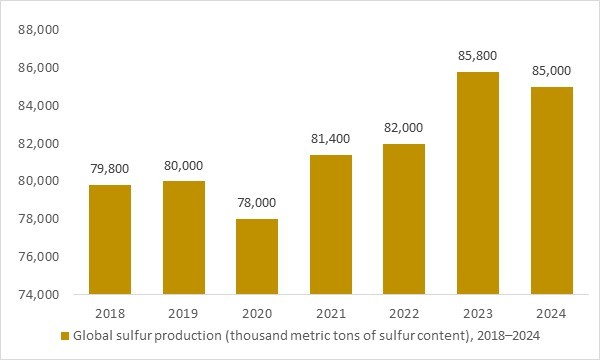"The Global Persulfate Market is valued at USD 113 Million in 2025. Worldwide sales of Advanced Lead Acid Battery Market are expected to grow at a significant CAGR of 3.5%, reaching USD 143.8 Million by the end of the forecast period in 2032."
The global persulfate market is witnessing steady growth driven by its extensive applications across polymer manufacturing, electronics, water treatment, soil remediation, and cosmetics industries. Persulfates, including ammonium, sodium, and potassium persulfate, are powerful oxidising agents used as initiators in polymerisation processes, etching agents in PCB manufacturing, and oxidisers in soil and groundwater remediation. Growing demand for lightweight polymers, increasing environmental remediation projects, and expanding semiconductor production are key market drivers. Companies are focusing on capacity expansions, technological advancements in production, and regional market penetrations to strengthen their competitive positions. However, handling and storage safety concerns due to persulfate’s reactive and oxidising properties remain a critical challenge for manufacturers and end users.
Asia-Pacific dominates the persulfate market owing to its strong polymer, electronics, and industrial manufacturing bases, with China, Japan, and South Korea being major consumers. North America and Europe are mature markets with stable demand in environmental and electronics applications. Rising environmental regulations, focus on sustainable water treatment, and growth in personal care formulations with persulfate-based bleaching agents are further supporting market growth. Players are also exploring alternative synthesis methods to improve cost efficiency and reduce environmental footprint, aligning with global sustainability goals while maintaining performance standards across diversified end-use applications.
By type, ammonium persulfate is the largest segment due to its wide use as a polymerisation initiator in manufacturing acrylics, PVC, and styrene-butadiene rubber. Its high solubility, cost-effectiveness, and strong oxidising properties make it the preferred choice across multiple industrial applications, driving consistent demand globally.
By end use, polymers is the largest segment as persulfates are extensively used as initiators in emulsion and solution polymerisation processes for producing synthetic rubbers, plastics, and resins. Rising demand for lightweight, durable polymers in automotive, construction, and packaging industries continues to drive growth in this segment worldwide.

Trade Intelligence for persulfate market
| Global Peroxosulphates persulphates Trade, Imports, USD million, 2020-24 | |||||
|
| 2020 | 2021 | 2022 | 2023 | 2024 |
| World | 187 | 233 | 251 | 185 | 168 |
| Italy | 20 | 24 | 21 | 16 | 18 |
| Korea, Republic of | 26.0 | 23.4 | 20.1 | 13.8 | 13 |
| Taipei, Chinese | 14 | 16.5 | 18.6 | 10.2 | 12.3 |
| United States of America | 8.0 | 15.0 | 15.8 | 9.6 | 10.7 |
| Canada | 5.5 | 10.1 | 10.6 | 10.2 | 10.6 |
| Source: OGAnalysis, International Trade Centre (ITC) | |||||
- Italy, Korea, Republic of, Taipei, Chinese, United States of America and Canada are the top five countries importing 38.2% of global Peroxosulphates persulphates in 2024
- Global Peroxosulphates persulphates Imports decreased by 10.2% between 2020 and 2024
- Italy accounts for 10.6% of global Peroxosulphates persulphates trade in 2024
- Korea, Republic of accounts for 7.6% of global Peroxosulphates persulphates trade in 2024
- Taipei, Chinese accounts for 7.3% of global Peroxosulphates persulphates trade in 2024
| Global Peroxosulphates persulphates Export Prices, USD/Ton, 2020-24 |
|
|
| Source: OGAnalysis |
Key Insights
- The persulfate market is primarily driven by its use as an initiator in polymerisation, especially for emulsion and solution polymerisation processes producing acrylics, styrene-butadiene rubber, and PVC, supporting widespread industrial and consumer product applications globally with consistent consumption growth.
- Ammonium persulfate is the most widely used type due to its cost-effectiveness and versatility as a strong oxidising agent and polymerisation initiator, particularly in the plastics and electronics industries where stable, efficient, and high-purity initiators are essential for quality outputs.
- Environmental remediation is an emerging application segment, with persulfates used in in-situ chemical oxidation (ISCO) to treat contaminated soil and groundwater, driven by stringent environmental regulations and increasing brownfield redevelopment projects worldwide.
- Asia-Pacific leads the market due to strong manufacturing activities, high demand for polymers and semiconductors, and favourable industrial growth in China, Japan, South Korea, and India, supported by regional production capacities and domestic consumption.
- In the electronics sector, persulfates such as sodium and ammonium persulfate are used as etching agents for printed circuit boards, with rising demand driven by global expansion of consumer electronics, automotive electronics, and semiconductor manufacturing industries.
- Key companies are focusing on capacity expansions, mergers, and strategic partnerships to secure raw material supply, optimise distribution networks, and strengthen regional presence, especially in high-growth Asia-Pacific and Middle East & Africa markets.
- Safety concerns related to persulfate handling, storage, and transportation due to its reactive, oxidising nature require stringent regulatory compliance and robust operational safety measures to prevent environmental and health hazards across manufacturing and application processes.
- Technological advancements in persulfate production processes aim to improve yield, reduce energy consumption, and minimise environmental footprint, aligning with sustainability goals and enhancing competitiveness in the global specialty chemicals market.
- The cosmetics and personal care segment is witnessing growing adoption of persulfates as bleaching and lightening agents in hair colour formulations, driven by increasing consumer demand for personal grooming products and professional salon treatments globally.
- Stringent wastewater treatment regulations are boosting demand for persulfates in industrial and municipal water treatment applications as effective oxidising agents for contaminant removal and wastewater conditioning, supporting environmental compliance and sustainability initiatives.
Global sulfur production (thousand metric tons of sulfur content), 2018–2024
Figure: Global sulfur production (thousand metric tons, sulfur content), 2018–2024, illustrating the stable feedstock base supporting growth in the Persulfate market.
- Global sulfur production from 2018 to 2024 provides a strong upstream indicator for the Persulfate market, as persulfates are synthesized from sulfur-based chemistries. The steady and resilient sulfur output over these years reflects a stable raw material base, supporting expanding demand from electronics, polymer processing, water treatment, and environmental remediation applications. This trend reinforces the market’s long-term supply security and highlights the depth of analysis behind OG Analysis’ Persulfate market insights.
Report Scope
| Parameter | persulfate market scope Detail |
| Base Year | 2024 |
| Estimated Year | 2025 |
| Forecast Period | 2026-2032 |
| Market Size-Units | USD billion |
| Market Splits Covered | By Type,By End-user |
| Countries Covered | North America (USA, Canada, Mexico) |
| Analysis Covered | Latest Trends, Driving Factors, Challenges, Trade Analysis, Price Analysis, Supply-Chain Analysis, Competitive Landscape, Company Strategies |
| Customization | 10% free customization (up to 10 analyst hours) to modify segments, geographies, and companies analyzed |
| Post-Sale Support | 4 analyst hours, available up to 4 weeks |
| Delivery Format | The Latest Updated PDF and Excel Data file |
Market Segmentation
By Type
- Ammonium
- Potassium
- Sodium
By End Use
- Polymers
- Electronics
- Cosmetics & Personal Care
- Pulp, Paper & Textiles
- Oil & Gas
- Water Treatment
- Soil Remediation
- Others
By Geography
- North America (USA, Canada, Mexico)
- Europe (Germany, UK, France, Spain, Italy, Rest of Europe)
- Asia-Pacific (China, India, Japan, Australia, Rest of APAC)
- The Middle East and Africa (Middle East, Africa)
- South and Central America (Brazil, Argentina, Rest of SCA)
Key Companies
- Evonik Active Oxygens
- RheinPerChemie
- UI VR Persulfates (United Initiators)
- MITSUBISHI GAS CHEMICAL COMPANY, INC.
- Fujian ZhanHua Chemical Co., Ltd.
- Ak-Kim
- Yatai Electrochemistry Co. Ltd.
- Hebei Jiheng Group
- Fujian Jianou Yongsheng Industry
- San Yuan Chemical Co., Ltd.
Available Customizations
The standard syndicate report is designed to serve the common interests of Persulfate Market players across the value chain and include selective data and analysis from entire research findings as per the scope and price of the publication.
However, to precisely match the specific research requirements of individual clients, we offer several customization options to include the data and analysis of interest in the final deliverable.
Some of the customization requests are as mentioned below :
Segmentation of choice – Our clients can seek customization to modify/add a market division for types/applications/end-uses/processes of their choice.
Persulfate Pricing and Margins Across the Supply Chain, Persulfate Price Analysis / International Trade Data / Import-Export Analysis
Supply Chain Analysis, Supply–Demand Gap Analysis, PESTLE Analysis, Macro-Economic Analysis, and other Persulfate market analytics
Processing and manufacturing requirements, Patent Analysis, Technology Trends, and Product Innovations
Further, the client can seek customization to break down geographies as per their requirements for specific countries/country groups such as South East Asia, Central Asia, Emerging and Developing Asia, Western Europe, Eastern Europe, Benelux, Emerging and Developing Europe, Nordic countries, North Africa, Sub-Saharan Africa, Caribbean, The Middle East and North Africa (MENA), Gulf Cooperation Council (GCC) or any other.
Capital Requirements, Income Projections, Profit Forecasts, and other parameters to prepare a detailed project report to present to Banks/Investment Agencies.
Customization of up to 10% of the content can be done without any additional charges.
Note: Latest developments will be updated in the report and delivered within 2 to 3 working days.
Recent Developments
- Fujian ZhanHua Chemical is commissioning its third-phase project for potassium persulfate, which will raise its annual output from ~12,000 tons to about 30,000 tons, enhancing its global supply footprint.
- Evonik’s KLOZUR portfolio continues to be deployed in field remediation: several case studies show rapid achievement of cleanup goals using its persulfate products for soil and groundwater contamination (e.g. TCE, hydrocarbons) under various activation conditions.
Research Methodology
Our research methodology combines primary and secondary research techniques to ensure comprehensive market analysis.
Primary Research
We conduct extensive interviews with industry experts, key opinion leaders, and market participants to gather first-hand insights.
Secondary Research
Our team analyzes published reports, company websites, financial statements, and industry databases to validate our findings.
Data Analysis
We employ advanced analytical tools and statistical methods to process and interpret market data accurately.
Get Free Sample
At OG Analysis, we understand the importance of informed decision-making in today's dynamic business landscape. To help you experience the depth and quality of our market research reports, we offer complimentary samples tailored to your specific needs.
Start Now! Please fill the form below for your free sample.
Why Request a Free Sample?
Evaluate Our Expertise: Our reports are crafted by industry experts and seasoned analysts. Requesting a sample allows you to assess the depth of research and the caliber of insights we provide.
Tailored to Your Needs: Let us know your industry, market segment, or specific topic of interest. Our free samples are customized to ensure relevance to your business objectives.
Witness Actionable Insights: See firsthand how our reports go beyond data, offering actionable insights and strategic recommendations that can drive your business forward.
Embark on your journey towards strategic decision-making by requesting a free sample from OG Analysis. Experience the caliber of insights that can transform the way you approach your business challenges.
FAQ's
By 2031, the Persulfate Market is estimated to account for USD 143.8 million
The Global Persulfate Market is estimated to generate USD 113 million in revenue in 2025
The Global Persulfate Market is expected to grow at a Compound Annual Growth Rate (CAGR) of 3.5% during the forecast period from 2025 to 2031.
$3950- 30%
$6450- 40%
$8450- 50%
$2850- 20%
Didn’t find what you’re looking for? TALK TO OUR ANALYST TEAM
Need something within your budget? NO WORRIES! WE GOT YOU COVERED!


